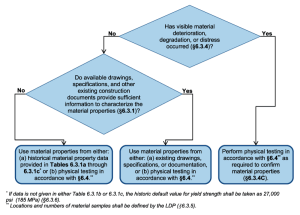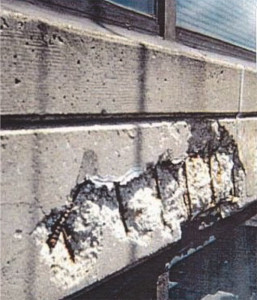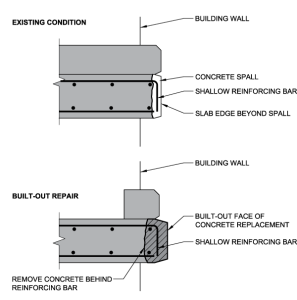In 2013, the American Concrete Institute (ACI) published the first U.S. code requirements specifically for the repair of reinforced concrete, Code Requirements for Evaluation, Repair and Rehabilitation of Concrete Buildings (ACI 562-13), having recognized the need for consistent practices and longer-lasting concrete structures.
This was also ACI’s first performance-based code. The distinction between prescriptive and performance requirements is an important one for concrete repair, as project conditions such as a structure’s age, materials used, and strength requirements can vary widely. Thus, ACI 562 is structured to afford licensed design professionals significant flexibility in selecting materials and devising customized repair strategies, while following a minimum baseline of code requirements.
ACI and the International Concrete Repair Institute (ICRI) have now published the Guide to the Code for Evaluation, Repair, and Rehabilitation of Concrete Buildings (referred to herein as the Guide) as a companion to the code, which will help designers clearly and quickly interpret new, performance-based provisions of ACI 562 that directly impact the way they approach concrete repair.
How the Guide Works
While ACI 562 offers many alternative ways to repair concrete, solutions for specific projects are ultimately up to the designer’s interpretation and professional judgment. The Guide addresses users’ most fundamental concerns in a straightforward format, with Chapter Guides and Project Examples that provide resources to help identify the most effective repair strategies.
Chapter Guides mirror each section of ACI 562, providing insight into how each chapter and section of the code applies to different aspects of concrete repair, including:
- Notation and Definitions
- Referenced Standards
- Basis for Compliance
- Loads, Load Combinations, and Strength Reduction Factors
- Evaluation and Analysis
- Design of Structural Repairs
- Durability
- Construction, and
- Quality Assurance
The Guide provides flowcharts illustrating how to navigate key decisions, such as determining material properties at the jobsite (Figure 1). In this example, an engineer can use the visual reference to quickly identify which sections of ACI 562 to reference when conducting a visual inspection, reviewing available documentation, and performing physical testing.

Figure 1. Summary of process to determine material properties in accordance with ACI 562, Section 6.3.
Highlighted call-out boxes in each chapter explain scenarios that may require more interpretation or unusual circumstances that are not directly referenced in the code, including “Unique Analysis Considerations” designers might encounter during a concrete repair project (see sidebar). Call-out boxes also list additional references for specific repair topics, such as other standards and guides for evaluating and repairing reinforcement in concrete structures.
To reinforce the material covered in the Chapter Guides, several Project Examples illustrate how ACI 562 applies to actual concrete repair scenarios:
- Typical parking garage repairs,
- Typical façade repairs,
- Repair of a historic structure for adaptive reuse,
- Strengthening of a two-way flat slab, and
- Strengthening of double-tee stems for shear.
Although the code was not in existence at the time these projects were completed, real-world examples have been adapted to demonstrate how the code could have been used. Rather than giving prescriptive formulas for concrete repair, the examples show how designers can draw on relevant sections of ACI 562 to meet unique project conditions.
The project scenarios include architectural drawings, photographs, and details to help designers become familiar and comfortable with applying the new repair code. For example, the guide walks users through a typical façade repair project, in which concrete corrosion occurred in a 1970s residential building (Figure 2).
In a column alongside the project description, designers can see which sections of ACI 562 would apply to each step, beginning with evaluating the structure and selecting the best repair approach. Drawings illustrate the structure’s existing condition and several repair options, including the approach that was ultimately selected (Figure 3).
The Guide also refers designers to ACI 562 provisions that govern the preparation of contract documents, actual construction and quality assurance processes, and communication of maintenance instructions with the project owner.
The Guide concludes with several references, including an overview of ACI 562 provisions and where they are referenced within the Guide. Designers can quickly find cross references to a specific section of the code within a chapter or Project Example, without having to review the entire guide.
The Guide in Practice
As with any new code, the designer’s first challenge is recognizing when to reference ACI 562 as opposed to ACI 318, the International Existing Building Code (IEBC), or other standards. The purpose of ACI 562 is to provide a comprehensive standard for concrete repair projects from inception to completion, including provisions not addressed by previous standards.
However, where provisions do overlap, the Guide explains how the code references existing standards to specify, clarify, or expand upon new requirements. For example, Section 5.1.6 of ACI 562 requires the use of ASCE/SEI 7-10, Minimum Design Loads for Buildings and Other Structures, for gravity and wind load requirements, but references ASCE/SEI 41-06, Seismic Rehabilitation of Existing Buildings, for the treatment of seismic loads.
Designers can also follow the code’s repair program to determine initial causes of deterioration, assess the compatibility and durability of various repair materials with the existing structure, and communicate appropriate maintenance practices with clients. The Guide’s Project Examples illustrate ways to apply these durability requirements and considerations to achieve a longer service life.
Used in conjunction with ACI 562, the Guide to the Code for Evaluation, Repair, and Rehabilitation of Concrete Buildings helps design professionals apply new code provisions that are increasingly becoming standard practices. Although ACI 562 is compatible with the IEBC, it has not yet been adopted into the international code. However, when adopted by local jurisdictions and building authorities, ACI 562 provides a means of acceptance for the repair of reinforced concrete structures. For more information about ACI 562, see Requirements for Evaluation, Repair and Rehabilitation of Concrete Buildings, in STRUCTURE, September 2014.▪
The Guide to the Code for Evaluation, Repair, and Rehabilitation of Concrete Buildings is available as a bundle including a copy of ACI 562-13 and as a standalone document at www.concrete.org and www.icri.org.
Unique Analysis Considerations
Numerous situations are encountered with existing structures that require unique analysis considerations, both for the existing structure and the design of repairs. ACI 562 specifies that the licensed design professional consider the various analysis aspects of each situation. Although not intended to be comprehensive, the following scenarios present unique analysis considerations for various cases:
- Spalling has occurred at the top side of a continuous girder, resulting in loss of bond at some of the top longitudinal reinforcing steel. The damage may have caused loss of development in the reinforcing steel and additional structural demand in other portions of the existing structure as a result of redistribution of the negative moments.
- Full-depth slab repair is required to address top and bottom reinforcing bar corrosion in a parking deck. During repairs, the unbraced length of the adjacent columns could significantly increase and temporary bracing of the column may be required.
- Alterations as a result of change of occupancy will include new openings in a two-way slab. The demolition for the alteration may result in redistribution of existing moments and shear forces in the remaining structure.
- Damage, deterioration, or repairs of a prestressed concrete structure that may have resulted or will result in prestressing force release (reference ACI 562, Section 7.6.4). Repairs that affect the development of prestressing steel reinforcement may reduce member capacity.
- Concrete spalling has occurred on a column. The concrete removal during repair may result in redistribution of internal forces that are locked-in. The strength of such columns must be considered in accordance with Section 6.5.4 of ACI 562.
Excerpted from the Guide to the Code for Evaluation, Repair, and Rehabilitation of Concrete Buildings, ACI and ICRI 2015.
References
1. Guide to the Code for Evaluation, Repair and Rehabilitation of Concrete Buildings, American Concrete Institute and International Concrete Repair Institute, Farmington Hills, MI, 2015, 140 pp.
2. Code Requirements for Evaluation, Repair and Rehabilitation of Concrete Buildings (ACI 562-13) and Commentary, American Concrete Institute, Farmington Hills, MI, 2013, 59 pp.
3. Building Code Requirements for Structural Concrete (ACI 318-14), American Concrete Institute, Farmington Hills, MI, 2014, 520 pp.
4. International Existing Building Code, International Code Council, Country Club Hills, IL, 2006, 484 304 pp.
5. Minimum Design Loads for Buildings and Other Structures (ASCE/SEI 7-10), American Society of Civil Engineers, 1801 Alexander Bell Drive, Reston, VA 20191, 658 pp.
6. Seismic Rehabilitation of Existing Buildings (ASCE/SEI 41-13), American Society of Civil Engineers, 1801 Alexander Bell Drive, Reston, VA 20191, 555 pp.


